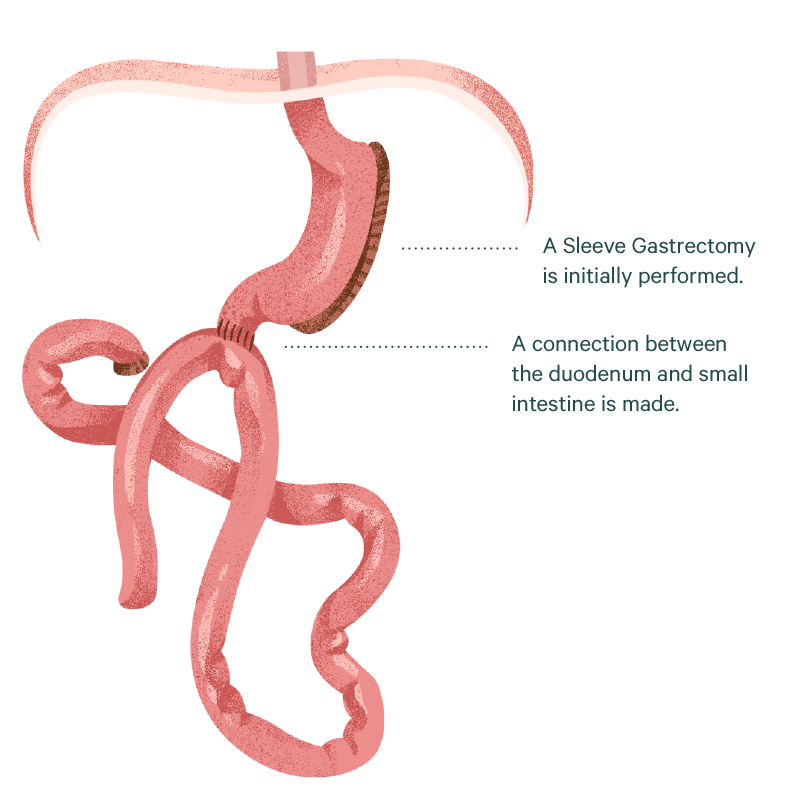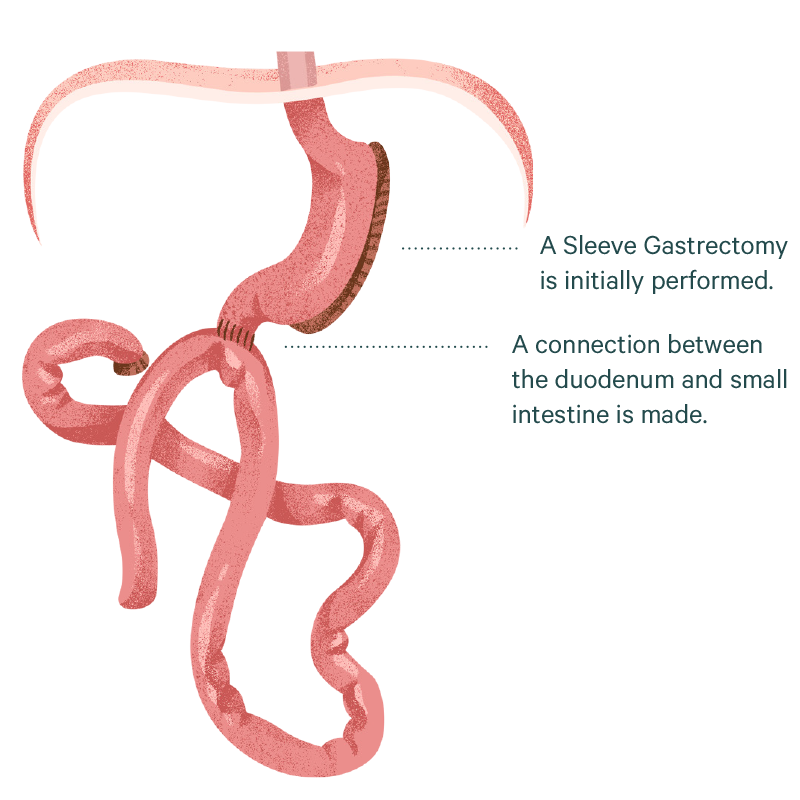Single Anastomosis Duodenal Ileal Bypass (SADI-I)

What is a SADI-S?
A SADI-S involves a traditional Sleeve Gastrectomy plus a reconfiguration of your digestive tract. The sleeve component involves decreasing the size of your stomach to a thin short tube. It works by making you feel full quicker so that you eat smaller amounts. The rerouting of the food stream produces changes in gut hormones that promote satiety, suppress hunger, and reverse some of the mechanisms by which obesity induces type 2 diabetes.
Is a SADI-S suitable for me?
If your BMI score is over 50 and you have other medical problems such as Type-2 diabetes, or high blood pressure, weight loss surgery may help you achieve your long-term weight loss goals. If you have experienced weight regain after a sleeve, the SADI component alone may be a good option for you.
What does the operation involve?
The Single Anastomosis duodenal ileal bypass – abbreviated SADI – is a procedure with two components. First, a smaller, tubular stomach pouch is created by removing a portion of the stomach, like the sleeve gastrectomy. Next, a large portion of the small intestine is bypassed.
The duodenum, or the first portion of the small intestine, is divided just past the outlet of the stomach. A segment of the distal (last portion) small intestine is then brought up and connected to the outlet of the newly created stomach, so that when the patient eats, the food goes through a newly created tubular stomach pouch and empties directly into the last segment of the small intestine. Roughly three-fourths of the small intestine is bypassed by the food stream.
The bypassed small intestine, which carries the bile and pancreatic enzymes that are necessary for the breakdown and absorption of protein and fat, eventually mix with the food stream. SADI initially helps to reduce the amount of food that is consumed; however, over time this effect decreases, and patients are able to eventually consume near “normal” amounts of food.
The food does not mix with the bile and pancreatic enzymes until very far down the small intestine. This results in a significant decrease in the absorption of calories and nutrients (particularly protein and fat) as well as nutrients and vitamins dependent on fat for absorption (fat soluble vitamins and nutrients). SADI, like the gastric bypass and sleeve gastrectomy, affects guts hormones in a manner that impacts hunger and satiety as well as blood sugar control.
SADI is the most effective bariatric surgical procedure for the treatment of diabetes.
How soon will I recover?
You should be able to go home after 2-3 days in hospital. You will be able to drink only liquids for a few weeks, moving to soft food and then to solid food.
You should be able to return to work after 2-4 weeks, depending on how much surgery you need and your type of work. Early light exercise is encouraged to help you return to normal activities as soon as possible.
What are the benefits of SADI-S?
— Results in greater weight loss than RYGB or LSG i.e. 60–70% excess weight loss or greater, at 5-year follow-up.
— Allows patients to eventually eat close to“normal” meals.
— Reduces the absorption of fat by more than 70%.
— Causes favourable changes in gut hormones to reduce appetite and improve satiety.
— Is the most effective intervention against diabetes compared to RYGB or OAGB.
What complications can happen?
— Has higher complication rates and risk for mortality than the band, sleeve, and bypass.
— Has a greater potential to cause protein deficiencies and long-term deficiencies in a number of vitamins and minerals, i.e. iron, calcium, zinc, fat-soluble vitamins such as vitamin D.
—Compliance with follow-up visits, care, and strict adherence to dietary and vitamin supplementation guidelines are critical to avoiding serious issues from protein and certain vitamin deficiencies.
Robotic Surgery
Robotic surgery is a rapidly evolving field. Bariatric surgery can be performed with robotic technology and Dr. Magdy completed his fellowship in robotic bariatric surgery overseas. Robotic technology has significant advantages however at present incurs higher costs. If you wish to have your bariatric procedure performed robotically, please discuss this with Dr. Magdy.
What is a SADI-S?
A SADI-S involves a traditional Sleeve Gastrectomy plus a reconfiguration of your digestive tract. The sleeve component involves decreasing the size of your stomach to a thin short tube. It works by making you feel full quicker so that you eat smaller amounts. The rerouting of the food stream produces changes in gut hormones that promote satiety, suppress hunger, and reverse some of the mechanisms by which obesity induces type 2 diabetes.

Is a SADI-S suitable for me?
If your BMI score is over 50 and you have other medical problems such as Type-2 diabetes, or high blood pressure, weight loss surgery may help you achieve your long-term weight loss goals. If you have experienced weight regain after a sleeve, the SADI component alone may be a good option for you.
What does the operation involve?
The Single Anastomosis duodenal ileal bypass – abbreviated SADI – is a procedure with two components. First, a smaller, tubular stomach pouch is created by removing a portion of the stomach, like the sleeve gastrectomy. Next, a large portion of the small intestine is bypassed.
The duodenum, or the first portion of the small intestine, is divided just past the outlet of the stomach. A segment of the distal (last portion) small intestine is then brought up and connected to the outlet of the newly created stomach, so that when the patient eats, the food goes through a newly created tubular stomach pouch and empties directly into the last segment of the small intestine. Roughly three-fourths of the small intestine is bypassed by the food stream.
The bypassed small intestine, which carries the bile and pancreatic enzymes that are necessary for the breakdown and absorption of protein and fat, eventually mix with the food stream. SADI initially helps to reduce the amount of food that is consumed; however, over time this effect decreases, and patients are able to eventually consume near “normal” amounts of food.
The food does not mix with the bile and pancreatic enzymes until very far down the small intestine. This results in a significant decrease in the absorption of calories and nutrients (particularly protein and fat) as well as nutrients and vitamins dependent on fat for absorption (fat soluble vitamins and nutrients). SADI, like the gastric bypass and sleeve gastrectomy, affects guts hormones in a manner that impacts hunger and satiety as well as blood sugar control.
SADI is the most effective bariatric surgical procedure for the treatment of diabetes.
How soon will I recover?
You should be able to go home after 2-3 days. You will be able to drink only liquids for a few weeks, moving to soft food and then to solid food.
You should be able to return to work after 2-4 weeks, depending on how much surgery you need and your type of work. Early light exercise is encouraged to help you return to normal activities as soon as possible.
What are the benefits of SADI-S?
— Results in greater weight loss than RYGB or LSG i.e. 60–70% excess weight loss or greater, at 5-year follow-up.
— Allows patients to eventually eat close to“normal” meals.
— Reduces the absorption of fat by more than 70%.
— Causes favourable changes in gut hormones to reduce appetite and improve satiety.
— Is the most effective intervention against diabetes compared to RYGB or OAGB.
What complications can happen?
— Has higher complication rates and risk for mortality than the band, sleeve, and bypass.
— Has a greater potential to cause protein deficiencies and long-term deficiencies in a number of vitamins and minerals, i.e. iron, calcium, zinc, fat-soluble vitamins such as vitamin D.
—Compliance with follow-up visits, care, and strict adherence to dietary and vitamin supplementation guidelines are critical to avoiding serious issues from protein and certain vitamin deficiencies.
Robotic surgery is a rapidly evolving field. Bariatric surgery can be performed with robotic technology and Dr. Magdy completed his fellowship in robotic bariatric surgery overseas. Robotic technology has significant advantages however at present incurs higher costs. If you wish to have your bariatric procedure performed robotically, please discuss this with Dr. Magdy.